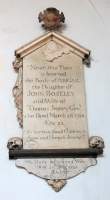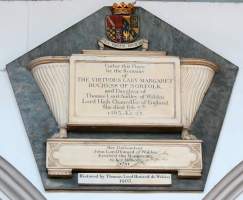
This medieval Norwich church is close to the Marketplace, a flint faced edifice with a square tower, and inside an airy space with a high ceiling, bright light from the windows, some of which have stained glass – one of these, to the left hand side as we face the altar, is an excellent specimen of late 19th Century work; see detail above. At the bases of shafts on the walls are small corbels with angels holding open bibles. There are a variety of medieval brasses showing male and female figures, interesting but outside the scope of these pages, and other things of artistic merit, notably a little panel of an angel blowing a trumpet, on a gilded Gothic backing, and the font, with inlay and on a thick clustered shaft.
For the sculptural interests of these pages, the church has a good variety of monuments including a couple by important Norwich sculptors, and three significant monuments from around the 1600s.
 Glory, from the Layer Monument, after 1604.
Glory, from the Layer Monument, after 1604.
The Layer Monument is the most splendid, with the two kneeling figures of Christopher Layer (d.1600) and his wife Ann (d.1604), conventionally facing each other over the usual central desk (see this page for more on kneeler monuments), and with their offspring, of smaller size, ranked behind them. They are ruffed, he wearing red robes, with three sons kneeling behind, one of whom is a boy. Five daughters rank behind his wife. There is a skull above the usual centre desk. The background above shows their respective coats of arms, with surrounding ribbons, and painted central sunburst, blue sky and clouds. Big crest with further coat of arms above, inscription below shelf and painted apron below with simple design and repeating ribbons. Dates 1600, 1604 on both inscription and apron.
Wide pilasters on each side contain niches with high relief figs, two on each side. Peace and Vanity, left, and Glory and Labour right. All rather solid, crude little painted figs, Peace is a buxom woman, holding the usual sprig of leaves, astride a small globe trampling spear and pennant. Her rolled up sleeves and brawny arms are set off by her split skirt exposing one muscular leg. Vanity is a naked cherub holding some trifles. Glory, the best figure, is a plump dancing girl, with some light upper garment to emphasise breasts and stomach, and nice swaying pose. Finally Labour is a lively bearded man in a short tunic with spade (the half is missing) and a skull next to him as if he had just dug it up.
The second Tudor monument is that to Nicholas (d.1540) and Agnes Sotherton, just two kneelers, male and female, robed, with desk. Their faces have an interesting sophisticated ugliness more familiar from 17th C German woodcuts. Coats of arms between dark pillars, conventional pediment and entablature above, shelf and inscription below, modest brackets.
Thirdly, and now in Stuart times, we have Thomas Sotherton, d.1608, and wife Francis Fox, widow of John Fox. The inscription notes 2 sons and 6 daughters; and the mural includes the pair of sons on the left, the younger of whom died young (holding skull). On the right we see only five daughters, two with skulls, all terrifyingly bewigged and with plump chins, cheeks, and severe noses, features somewhat calmed but recognisably related in the mother. The man with straight combed hair, moustache and goatee beard painted rather red-faced.
Above and between the kneelers is his coat of arms to left with ribbons, hers a blank shield – as the gentleman looking after the church put it, signifying his title marrying her money. More detailed inscriptions below each figure. The left side starts ‘Under this could marbell sleepes/ Hee for whome even marbell weeps etc etc../ Of gentell blud more worthy merit/ whose brest enclosed an humbell sperryt/Oh Death thow hast ye boddy wone/ of worthy Thomas Sothertone.’ The right hand side carries on in similar vein. Below is an apron with raised design on a black marble backing. To the side, square unornamented pilasters of some marble support a heavy shelf and entablature, with central roundel with shield surmounted by a helmet.
Blomefield, writing in the 1800s, saw other monuments, including a memorial to John Marsham, with effigies of him and wife and five sons and eight daughters, and one to Robarte Rugge, d.1558, twice Mayor, and his wife Elizabeth, with statues of the two of them, and four sons, but with the daughters lost. He noted that the Virtuous Lady Margaret, Duchess of Norfolk, who died in the Duke’s Palace (also in Norwich) in 1563 had been buried in the church with great ceremony, but saw no monument.
 Abigail Boseley Monument, by Augustus Curtis and son.
Abigail Boseley Monument, by Augustus Curtis and son.
The main monuments from the 18th Century are those to Thomas Bubbin and to Abigail Jenney. That to Thomas Bubbin, d.1717, Late Captain of the Militia and Mayor of Norwich, and wife Mary, d.1705, is in the organ gallery. It is an ambitious monument – a plaque with a top shaped to make a small shelf on which stands, or stood as it is broken off, a cherub wearing a wisp of cloak, holding a knight’s helm and, now lost, perhaps a staff. Unusually fine treatment, especially of the face with its falling lock of hair. It shelters in a niche formed by two hanging drapes, pulled aside and knotted. The base shelf is toothed like the edge of a shell. All pale and grey streaked marble, on a black backing.
Abigail (d.1728), daughter of John Boseley (whose monument may be seen in St Michael at Plea), and wife of Thomas Jenney, and two offspring, second wife Mary, d.1729 and son. The monument is a pale plaque with open pediment, enclosing a winged cherubic head, nice falling drapes in place of pilasters to the left, with that on the right missing, a heavy base shelf with two skulls on it, and shallow shaped apron with a single bracket designed as a leaf. On top is a coat of arms on a tiny cartouche, very darkened, looking as if from a different monument. Nice swirly lettering, and signed unusually boldly, by A. Curtis in an inscribed semicircle. The Curtises, father and son, both called Augustine, were significant Norwich masons and sculptors, and their own memorial is in St Peter Mancroft.
John Rushbrook, d.1748, and wife Elizabeth, d.1738, a nice cartouche with scrolls, very three dimensional, with a pair of plump winged cherubic heads below, in pale stone, much darkened.
Robert Rushbrook, d.1781, and wife Sarah, d.1788, and offspring Mary (1775) and Sarah (1805). High up, a white coffer tomb end with curly side pieces, shelf and elegant thin stemmed classical pot above with garlands, shell drinking horns to left and right, a nice touch, and an apron with winged cherub head on crossed torch and perhaps a sword (broken) below. The backing of speckled and streaky grey marble rises in a tall obelisk shape.
Theodosia, beloved wife of William Emperor of Brook, ‘a gentle woman of amiable Endowments’, d.1752, and William, d.1761. A pale, spiky-edged panel on a broader, shaped backing to give the effect of pilasters. An open pediment is above, enclosing a crown; a pot seems to have been lost from the top. Beneath, an apron with coat of arms and exquisite little cartouche surround.
We also have a late 18th Century monument erected to Lady Margaret, Duchess of Norfolk, noted above. The inscription reads that this is ‘The Virtuous Lady Margaret, duchess of Norfolk, d. 1563, daughter of Thomas Lord Audley of Walton, Lord High Chancellor of England, erected by her descendent John Lord Howard of Walden 1791, and restored by Thomas Lord Howard de Walden 1903’. This inscription almost covers a fluted coffer tomb of white marble seen side on, with a shield and crown and motto above, all on a pentagonal grey marble backing, giving a rather modern appearance. This is the work of the sculptor John de Carle of Norwich (1750-1828).
Moving on to the 19th Century, our most significant monument is to perhaps a relative, Robert de Carle, d.1837, his wife Mary, d.1824, and son Edward, d.1814. A tomb end with receding fluted sides, as if splayed pilasters, thin moulded feet, a lamp with flame and garlands above, on an arched backing of brecciated stone, like serpentine, with a narrow black frame.
 Monument to Lady Margaret, Duchess of Norfolk, by John de Carle of Norwich.
Monument to Lady Margaret, Duchess of Norfolk, by John de Carle of Norwich.
I also noted the following:
Note that the Churches Conservation Trust website, along with much other information on the personages buried in this and other Norfolk churches, contains an image archive: www.visitchurches.org.uk is the link.
Norwich Market Square // St Peter Mancroft // // St John Timberhill // St Michael at Plea
Sculpture pages // Introduction to church monuments
Visits to this page from 30 Jul 2012: 6,967